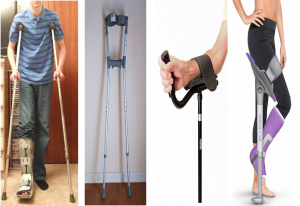4.3.3 Assistive Devices for Ambulation
In cases where clients require assistive devices to ambulate, there is a wide array of options, which we will discuss now.
Canes
Ambulation with a cane is a similar procedure to what you just learned. You will follow the same steps, but provide the client with their cane upon standing. The cane is used to allow the client to feel more secure while walking. The client may use one or two canes.

Other considerations when assisting a client with a cane include:
- Is the height of the cane correct for this client? Is the top of the cane at their wrist level?
- Is the handle of the cane correct for them (ask: can they easily hold the handle? does it fit their hand? is the grip adequate for them to be comfortable on the pad of their palm? is their hand too small to go around the handle? do they need a different grip?)
- Is the tip on the cane in good condition, or is it worn through, causing it to slip? Check the tip.
- Is the client using the cane on the correct side? The cane should be used on the strongest side, for a larger base support.
- Does the client need directions reviewed/reinforced for walking with a cane?
- Are they stable when using the 1-point cane? Do they need a cane with a wider base of support (4-point).
Crutches
Your client may be prescribed the use of crutches. The process of ambulation is similar to the above when the client uses one or two crutches, but extra considerations and attention will be needed when using some types of crutches. Specifically, it is important to assess the status of the underarm area due to the potential for the client to slouch and rest more weight on the underarm area, causing pain or nerve damage. Other types of crutches have bands to secure the crutch to the limb; these models require the skin to be checked frequently for tissue breakdown, damage from rubbing, or pressure.
Below are pictures of several types of crutches that may be used:

Walkers
Your client may be using a walker for ambulation. There are three main types of walkers. Walkers are used for clients that have weakness in their lower extremities and need more support than the cane or crutches will supply.
Some walkers have no wheels, while others have two wheels, three wheels or four wheels. The number of wheels should be selected depending on the stability of the client. A client who needs the assistance to walk for stability but not strength will likely use a rolling walker type with a seat for longer walks; a client who needs the walker for strength will likely use a walker without wheels so it provides good support for short walks in the home only; however, many are using stronger wheeled walkers for both applications now. The rolling walkers are supplied with brakes to reduce the chance of injuries due to movement when they are to remain stationary.
Below are pictures of several types of walkers. Click through the gallery by clicking the right or left arrows on the sides of the images, or click the dots found below the image:
As with all wheeled vehicles, a walker’s tires need to be checked for damage. Furthermore, check all working parts before use to avoid injury to the client.
It is also recommended that the client not use the walker to assist them to stand due to the potential for it to be unsteady and be a fall risk; they should instead place their hands on the chair arms or their knees to rise from a sitting position.
Practice Makes Perfect
This video will review information on using canes, crutches and walkers. After viewing the video, answer the questions below to check your understanding.
Click here for a video transcript in .docx format: Video Transcript
Braces and Prostheses
You may have clients that require the use of a leg or body brace or prosthesis to be applied prior to ambulating. Braces are used to stabilize body parts to allow them to withstand the pressure of the body weight while ambulating. The use of prostheses to replace missing body parts on humans has been practiced since 950-710 BC, according to the University of Pittsburgh Medical Center website. You will be trained how to assist the clients individually by a nurse, supervisor, occupational therapist, physical therapist, or the client.
Medical technology now makes it possible to create prostheses that look like their owner or are artistic creations. Some prostheses can be controlled by computer with nerve communication systems that allow the owners to think of a movement and have the prosthetic part respond. There are thousands of different types of prostheses. If you are to assist a client with their prosthetic part, you will be trained for the application prior to assisting the client.
Below are pictures of some braces and prostheses you may see used to assist in ambulation.
Practice Makes Perfect
This video clip, “How To Put On And Take Off An Above Knee Prosthesis” (7:44-12:51), shows the process of assisting someone with applying their leg prosthesis. Please be sure to begin watching at 7:44 and finish watching at 12:51.
Now, try to answer the questions below to check your understanding of what you watched:
Media Attributions
- Senior Lady Walking With Cane In Hagely Park, Christchurch © Mathew Sanders is licensed under a CC BY-NC-SA (Attribution NonCommercial ShareAlike) license
- crutches © Please see Image Description. adapted by Amanda Robinson is licensed under a CC BY-SA (Attribution ShareAlike) license

